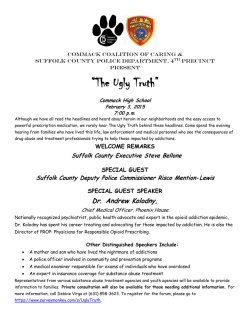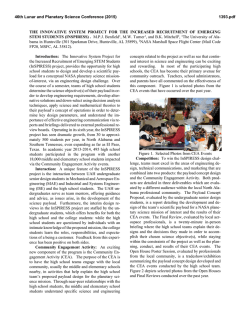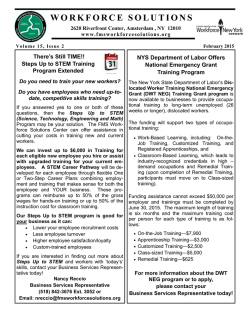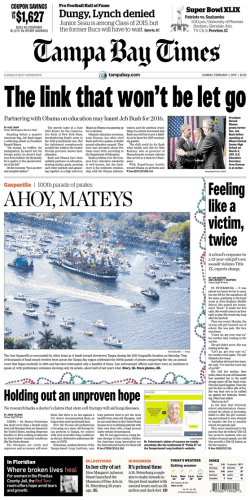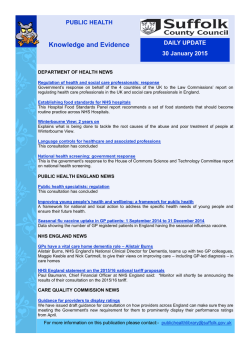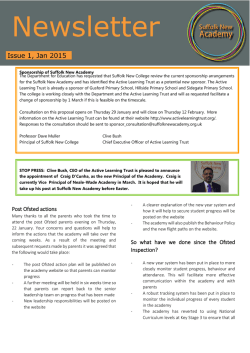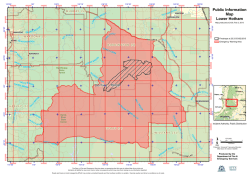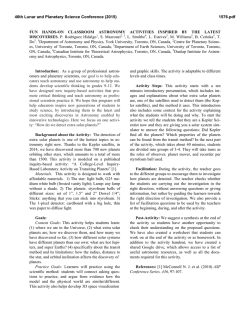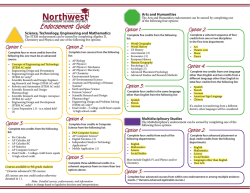
Spring into Science with STEM
The STANYS Suffolk Section & The Office of Educational Programs at BNL Spring into Science with STEM Friday, March 27, 2015 8:00 am to 3:30 pm Brookhaven National Lab Keynote Presentation by Dr. David Krause Department of Anatomical Sciences Stony Brook University Spring into Science with STEM Friday, March 27th, 2015 8:00 am – 3:30 pm Brookhaven National Laboratory Berkner Hall The Suffolk Section of STANYS and the Office of Educational Programs at BNL are delighted to invite you to our Spring Conference. You will have an opportunity to attend morning and afternoon workshops, and network at a multidisciplinary Share/Take-a-thon during breakfast and lunch. Our program has been designed to appeal to elementary, intermediate, and high school teachers. Directions to BNL can be found at www.bnl.gov. Please bring a photo ID, and when you arrive at the guard station, tell them you are a conference attendee. We are especially excited to be promoting STEM education, with special workshops geared for elementary, and middle school educators. High School educators have a wide variety of topics to choose from ranging from environmental science through astronomy and STEM. Several science organizations will be giving out free educational material in the lobby of Berkner Hall throughout the day. We also are offering two afternoon field trips, and two BNL workshops. Details can be found in the brochure. Register by March 14th for an early bird registration fee of $40 per person for STANYS members, $60 for non-members, and $25 for pre-service teachers (college students). Registration includes a light breakfast, all seminars/workshops/field trips and door prizes. Register online through Eventbrite. We look forward to seeing you on Friday, March 27th! Add $20 for walk in registration, or registration after March 14th,. Register Online at: http://springintosciencewithstem.eventbrite.com For further information, contact the Conference Co-Chairs, Joe Malave at [email protected], or James Ripka at [email protected]. Join STANYS now! We want you to become a STANYS member. Enjoy the conferences, field trips, programs, newsletters, standards updates, and more. Join STANYS at a cost of $44 when you register online and attend the conference for only $25.00 (new members only). Please bring your receipt. Combine the conference admission fee and STANYS membership for a total of $69! www.stanys.org/about/member-benefits.html Visit the STANYS Web Site for more information about STANYS www.stanys.org PROGRAM 8:00 am – 8:40 am Registration & Breakfast Share-athon 8:40 am – 9:40 am Keynote Address 9:40 am – 10:00 am NGSS & Strategic Science Plan Update 10:10 am – 11:05 am Session A 11:15 am – 12:10 pm Session B 12:15 pm - 1:15 pm Lunch (on your own) 1:20 pm - 2:20 pm Session C 2:30 pm- 3:30 pm Session D Keynote Address 8:40 am – 9:40 am Lecture Hall in Berkner Hall Opening Remarks by Glen Cochrane & Ken White Glen Cochrane - Vice President of STANYS, President – Suffolk STANYS Ken White – BNL, Manager – Office of Educational Programs Presentation by Dr. David Krause (Introduction by Gary Vorwald) Science with a Social Conscience: Discovering Dinosaurs and Helping Children in Madagascar David W. Krause - Ph. D., Distinguished Service Professor Department of Anatomical Sciences, Stony Brook University Founder and Executive Director - The Madagascar Ankizy Fund Dr. Krause will describe his scientific work in Madagascar, one of the most fascinating countries in the world, but also one of the poorest. He will detail how his discoveries of some of the world's most scientifically significant fossil vertebrates, including dinosaurs, led him to provide education and health care to thousands of children living in remote areas of Madagascar. Special Guest Presentation 9:40 am – 10:00 am The new New York State Science Standards Brian Vorwald - STANYS Past President, Associate Professor of ESS - Suffolk Community College, Earth Science Teacher/Science Department Chair – Sayville Public School (retired) Update on the Strategic Plan for Science, Next Generation Science Standards (NGSS), and the highly probable upcoming revision to New York State Science Standards Session A: (10:10 am – 11:05 am) A-1: Developing STEM Fluency, Design Thinking, and Strategic Innovation with LEGO Robotics: Sue Sorrrentino, Donna Chadback - Vista Teach Instructional Services STEM Educators at Allendale Columbia School, Rochester, NY LEGO robotics can be used for sustaining interest in the STEM disciplines and ultimately developing the capacity of young learners to become global leaders and innovators. Experience “instructional excerpts” of classroom PBL task in LEGO robotics. This workshop teaches structured and systemic sequences of project based building and programming task, which reinforces engineering principles and professional practices for middle school students. Learn how Project-Based Learning using LEGO Robotics, provides an authentic context of the real world via problem solving, and building STEM Fluency with 21st century skills. (STEM, Intermediate/High) A-2: Teach, Laugh, Breath: Diane Fonte - Saxton Middle School Whatever happened to the fun in teaching and learning? Maybe our reasons for becoming educators have changed a little. This humorous workshop will reinforce our efforts while still including the Common Core. Come see unique demonstrations and participate in some spirit reviving activities! (Intermediate, General) A-3: Trilobites, Crinoids, and Brachiopods, Oh My! Gary Vorwald - Gelinas Junior High School, Science Department Chair, Suffolk STANYS News Editor, Secretary, STANYS DAL, Science Olympiad Advisor & Award recipient, 2013 STANYS Award recipient How are fossils used to determine the age of rocks and interpret ancient environments? What are some common misconceptions about fossils and how they form? Enjoy a presentation about various invertebrate fossils and experience some lab activities on index fossils, ancient environments and correlation. Participants will gain a better understanding of all of those creatures in the Earth Science Reference Tables, and learn some activities that they can do in the classroom. Door prizes of real fossils will be distributed. (Earth Science, Biology, General, Levels 5-12) A-4: Bees! We Need Them! Laura Klahre – Owner, Beekeeper, Blossom Meadow LLC, MS Marine Science -SUNY Stony Brook As I can personally attest, pollinators are suffering massive losses but some bee populations may be more susceptible than others because of their specific life histories. While news reports center around the honeybee, there are actually 430 different bee species in New York State. Join veteran beekeeper Laura Klahre as she discusses the state of beekeeping today, factors contributing to the decline in bee populations, the effect fewer pollinators in the ecosystem will have on our own lives, and how the future of pollination for our farms and backyard gardens will undoubtedly have more of a focus on native pollinators including mason bees and leaf-cutter bees. (Biology, Environmental Science, All Levels) A5: Nanotechnology Workshop, NanoQuest: Funky Properties—Graphite vs. Graphene: BNL Office of Education Programs Explore material properties by making observations, measurements, and by conducting tests. Discover how nanotechnology and Brookhaven National Laboratory can become part of your curriculum with this one hour workshop on, “Funky Properties—Graphite vs. Graphene.” (STEM, Intermediate – High School) Session B: (11:15 – 12:10) B-1: Climate Change – It's Not Just about Us! Brian Vorwald - STANYS Past President, Associate Professor of ESS - Suffolk Community College, Earth Science Teacher/Science Department Chair – Sayville Public School (retired) This workshop will address how climate change through geologic time has been forced by natural processes. Participants will see that a variety of geologic processes and astronomical phenomena have played a significant role in the cooling and warming of our planet. Participants of this workshop will be shown that climate change is aligned with the current Physical Setting/Earth Science Core Curriculum. This workshop includes activities that you can use in your classrooms. (High School & Intermediate Earth Science) B-2: Can We See The Flag on the Moon? Steven Bellavia - BNL Principal Mechanical Engineer Large Synoptic Survey Telescope (LSST), SCCC adjunct professor in Astronomy and Mathematics Have you conducted an astronomy session with your students and heard that question, or one similar? This is a tongue and cheek workshop, filled with physics facts, and optical analysis that you can do yourself and with your students. A brief history of Galileo and what he could actually see with his telescope 400 years ago will be discussed. In addition, the present state of technology for land and space based telescopes will be discussed. Participants will be shown that using hand-held calculators (cell phone apps are fine), students will be able to determine the optical resolution limits of several telescopes. This workshop concludes by participants calculating the actual telescope aperture size (lens/mirror diameter), needed to see the flags left on the moon by Apollo missions. (Physics, Astronomy, STEM) B-3: Creative and Exploratory STEM in Your Classroom: Lauren Hubbard - Ph. D., Maritime Explorium at Port Jefferson Harbor Gets hands on with this interactive workshop as you experience the joys of best practices in STEM learning and teaching! Learn how to design and deliver creative, inquiry based STEM lessons, that will foster deep thinking and problem solving using readily available, inexpensive resources. We will share the research behind our methods and our lessons learned and successful strategies. You will leave with a fresh perspective on STEM in the elementary classroom. (Elementary, STEM) B-4: The Mariachi Experiment: Helio Takai, Ph. D. - Experimental Nuclear and Particle Physicist at Brookhaven National Laboratory. The Mariachi Experiment is an initiative to involve Physics Teachers and High School students in cosmic ray research. A century after the discovery of cosmic rays, we still don't know where they are coming from, or how they are accelerated. Cosmic ray particles such as protons and atomic nuclei are theorized to be created in Supernovas. The MARIACHI experiment proposed a method to detect cosmic rays using radar. The experiment depends on physics teachers and physics students to help in the new experimental redesign. In this workshop, you will learn how students, teachers, and researchers, are collaborating in this new phase, and the impact that students have had in the MARIACHI experiment. (High School Physics, STEM, Research) B-5: Yes, You Can Have Fun in Science Class Too! Ashley Bloch - NYS Master Teacher: Long Island Region, Suffolk STANYS Intermediate Level SAR, Islip Middle School Science Teacher Have you gotten into a rut? Need some ways to spice up your classroom and teaching? Well, look no further - this is the session for you! Here, we will look at various techniques you can use in your classroom that are so much fun, your students won't even realize that they are learning! They are student tested; teacher approved, and can be easily adapted for all levels of learning. (General, All Levels) Lunch Break (12:15 pm – 1:15 pm) Lunch is on your own. The Berkner Hall Cafeteria will be open. In addition, various science organizations will be in the lobby discussing their programs, and giving out samples. The souvenir shop will be open and is located adjacent to the lobby. Session C: (1:20 pm – 2:20 pm) Session D: (2:30 pm – 3:30 pm) C-1 & D-1: Field Trip to the Carolina Bays at Brookhaven Lab: Gil Hanson, Ph.D. -Distinguished Service Professor, Stony Brook University, Department of Geochemistry Doug Paquette – BNL, Ground Water Protection Unit Project Manager Carolina bays are elliptical to circular-shaped, shallow depressions, usually 100 hundreds of meters in diameter, which are found in abundance along the Atlantic Coastal Plain. They have recently been found in undeveloped areas of Suffolk County. Carolina bays are characterized by a closed elevated rim and a flat bottom. In this talk we will explore the possibility that the Carolina bays are secondary impact craters associated with a bolide that struck the Laurentide ice sheet 12,900 years ago at the beginning of the Younger Dryas cooling event and that the pebbly loess on Long Island is the ejecta from the secondary impacts. See, for example: www.cintos.org. Join Gil Hanson and Doug Paquette on a field trip to the North-West sector of the BNL property to explore these features. Bring adequate clothing for traveling through brush and fields. Participants will establish a car pool to the site. (Earth Science, Environment, All Levels) C-2 & D-2: Brookhaven Tour of Research Facilities: Tara Shiels – BNL Office of Stakeholder and Community Relations, Mel Morris, Ed. D., BNL Office of Education Programs – Manager of Special Projects, Open Space Stewardship Program -founder Have you ever wondered what kind of research is done at Brookhaven Lab, or wondered about the type of technology used to do research at the lab? Motivate your student’s interest in science by bringing them to Brookhaven National Laboratory, a unique and exciting setting where they can experience real-world science first hand. On this field trip across the BNL campus, you will visit various research sites and see firsthand the science and technology used at Brookhaven Lab. This is a guided bus tour, and seating is limited, so sign up early if you want a spot. The tour will be outdoors and indoors. Dress for the weather. (STEM, General, All levels) C-3: Alternative Energy: Solar BNL Office of Education Programs Did you know that the sun gives off more energy in one second, than people have used since the beginning of time? Each day, the need for alternative energy sources becomes increasingly more important. Solar Energy is a “hot” and relevant topic. In this workshop, you will engage in alternative energy hands-on activities that can be done in the classroom. Learn about solar panels and how different materials can impact their electrical output. Teachers will learn to design and build a solar water heater. This workshop supports NYS Science Core Curriculum Indicators. (Elementary, Intermediate) C-4: Demystifying Radio Astronomy: Justine Haupt - Brookhaven National Lab – Optical Engineer, Large Synoptic Survey Telescope camera design team, Custer Institute Board of Directors, actively engaged in STEM outreach. Does radio astronomy sound too complicated? Why bother? Radio astronomy can be performed any time, day or night. In this presentation, I hope to demystify radio astronomy and the process of forming images from radio emissions. By acknowledging radio waves as a color of light, and describing the instruments used to manipulate it, an understanding can be formed to dispel the misconception of radio astronomy as being complicated or somehow special. A brief overview of the science of observational radio astronomy will be included as well as a discussion on building a small radio telescope capable of generating images. (Astronomy, Physics, STEM, High School Level) C-5: Using Electrons to See Nanoscale Materials Eric Stach, Ph. D., BNL – Group Leader / Electron Microscopy, Center for Functional Nanomaterials I will describe how electrons can be used to make images at the atomic scale. Because electrons are small, charged particles, it is possible to make microscopes that use electromagnetic lenses that that focus very finely, leading to the ability to image the structure of materials at the atomic scale. These powerful instruments are routinely used to understand how nanostructured materials function, leading to better batteries, solar cells, and catalytic materials for energy conversion. (STEM, Chemistry, Physics, High School level) D-3: Flipping Out in Science: Aimee Mendoza, West Babylon High School, Earth Science, Chemistry, and Environmental Science Teacher I recently flipped my classroom after attending numerous workshops at the STANYS annual conference in Rochester last year and the boxes center in Wheatley heights and I'm going to pay it forward. (General, All levels) D-4: Can You Bear It? Maria Brown - Sayville High School Research Advisor/Teacher, Suffolk County Wetland Stewardship Committee Member, Vice President of the Coastal Research & Education Society of Long Island, BNL Molecular Ecology Educator, Suffolk STANYS Awards co-chair , Multiple Award Recipient, Distinguished Educator This is a hands on, ready to use lesson, on the comparative method, hypothesis testing, and phylogenetic tree analysis between the American black bear, brown bear, spectacled bear, Asian black bear, and the polar bear. Participants will be using NCBI, Mega Blast, and Mega 6.0 to obtain sequences files and produce Clustal W and phylogenetic trees for evolutionary analysis using BNL provided laptops. (High School Biology/Environmental Science) D-5: Teaching the Process of Research through Impact Crater Comparisons Stephanie Burns - BS Meteorology - SUNY Oneonta, MAT Earth Science - SUNY Stony Brook, OnAir Meteorologist WKTV (former), NWS SKYWARN Spotter, Suffolk STANYS, NESTA, Connetquot Foundation for The Advancement of Children - Grant Recipient Students studying astronomy can learn to complete a valid, thorough research project. This workshop is designed to introduce students to the process of science through the completion of a structured mini-research investigation focusing on impact craters on Earth and other planetary worlds in our Solar System. This presentation was adapted from a NASA Crater Comparisons Project - ARES Education - Johnson Space Center. (Earth Science, Research Science, STEM, Levels 8-12) Participants will not be able to access the Internet through their personal devices due to Homeland Security Controls.
© Copyright 2025
